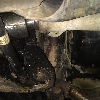- Joined
- June 17, 2004
- Messages
- 24,271
- Reaction score
- 4,741
- City, State
- Knoxville, TN
- Year, Model & Trim Level
- 98 Limited AWD 302
Okay, more suggestions; cut it all out and fabricate new pipes, leaving out the ball connections, weld in v-band clamp/flanges. Those never leak and are easy to R&R.












